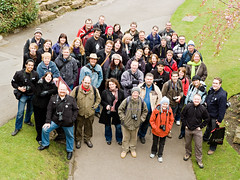 Before online social networks were created questions like this really never came up. Humans have had non-online social networks since the beginning of time – many of these network relied upon face-to-face communication and the information shared within them was not ‘persistent’ (i.e. the information shared in the face-to-face exchanges were not archived so that they could be accessed 5 or 10 years later). Another feature of common human social networks is that one person could belong to multiple social networks and these network were independant of each other and rarely mixed/overlapped. For example, I have many non-online social networks that I belong to where the memberships do not overlap. My work friends rarely meet my road hockey friends, or my university buddies, or my neighbours on my street. Each of my social networks is separated from the other with very infrequent overlaps. Most humans have lived their social lives like this. It has an interesting side effect. You can represent your image differently in each social network. That’s a good thing. To my road hockey buddies I would like to appear like an immature blood thirsty puck-loving daredevil; however, naturally I would like to display a different image of myself to my work friends. Non-online social networks allow me to safely have different ‘persona’ in a socially-acceptable way while still making honest and genuine social contact with individuals in the multiple social-networks that I belong.
Before online social networks were created questions like this really never came up. Humans have had non-online social networks since the beginning of time – many of these network relied upon face-to-face communication and the information shared within them was not ‘persistent’ (i.e. the information shared in the face-to-face exchanges were not archived so that they could be accessed 5 or 10 years later). Another feature of common human social networks is that one person could belong to multiple social networks and these network were independant of each other and rarely mixed/overlapped. For example, I have many non-online social networks that I belong to where the memberships do not overlap. My work friends rarely meet my road hockey friends, or my university buddies, or my neighbours on my street. Each of my social networks is separated from the other with very infrequent overlaps. Most humans have lived their social lives like this. It has an interesting side effect. You can represent your image differently in each social network. That’s a good thing. To my road hockey buddies I would like to appear like an immature blood thirsty puck-loving daredevil; however, naturally I would like to display a different image of myself to my work friends. Non-online social networks allow me to safely have different ‘persona’ in a socially-acceptable way while still making honest and genuine social contact with individuals in the multiple social-networks that I belong. Now go back to the questions in the first paragraph of this blog post. Can you see the problem? For example, Facebook lumps all your friends together into one bucket so now the image I portray to my university buddies on Facebook will be the same image I will portray to the parents of my students. In addition, the image I portray online is ‘persistent’. Theoretically, my status updates on Facebook may be searchable for years into the future. So online comments like – “Boy those first year chemistry students are stupid this year. I hate teaching Thursday mornings!” could really haunt me in the long run. This is very different than most non-online social networks where that comment only lives as long as someone can remember it. These differences could be dangerous – they are yellow-flags. The increased efficiency and effectiveness of online social networking brings with it this negative side effect.
Research is being undertaken right now to build more sophisticated online social networking concepts that mimic more closely non-online social networking phenomena while still providing the efficiency and effectiveness that we have come to expect of the Internet cloud. The Internet guarantees that as long as there are humans on Earth that online social networks will never die; however, how they are structured and how they operate will evolve.
Recently Paul Adams, a User Experience Researcher for Google in San Francisco, has published a useful presentation on SlideShare that outlines the problems and opportunities in designing the future of the online social network. Check out his presentation and let us know what you think by leaving a comment below. Also look for Paul Adams’ new book called Social Circles: How Offline Relationships Influence Online Behavior and What it Means for Design and Marketing. It’s due out in late summer 2010.
 Eric's ramblings, experiences and random thoughts about e-Learning, distance education and Educational Technology.
Eric's ramblings, experiences and random thoughts about e-Learning, distance education and Educational Technology.






No comments:
Post a Comment